Understanding Backlit Light Technology: Color Temperature, Brightness, and Energy Efficiency
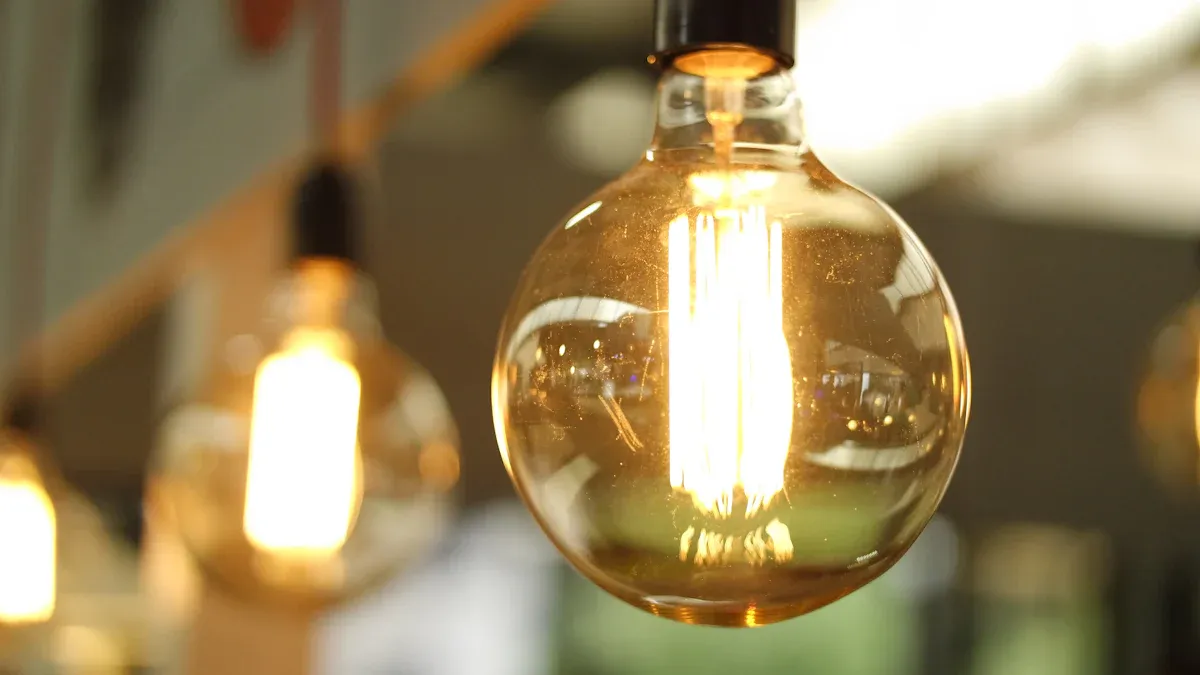
You use backlit light technology every day, even if you do not notice. This kind of lighting can change how you feel in a room. It can also affect how comfortable you are. Warmer or cooler color in lighting can make a space feel different. Studies show that higher color temperature can help you feel cooler. This may let you change your thermostat and save money on electricity. Think about how small changes in lighting can affect your mood. They can also change your comfort and even your spending.
Key Takeaways
Backlit light technology uses LEDs to give bright, even light. This type of light can make you feel better and more comfortable in any room.
Picking the right color temperature is very important. Warm light (2700K-3000K) makes a room feel cozy. Cool light (4000K-5000K) helps you stay awake and pay attention.
LED lighting saves energy. It uses up to 75% less power than old bulbs. Using LEDs can help you save a lot of money on your energy bills.
Brightness is important! Lumens show how much light you get. Different rooms need different brightness for comfort and work.
Smart lighting systems let you change brightness and color temperature easily. These systems can help you use less energy and make your home or office better.
Backlit Light Technology

How It Works
You see backlit light technology almost everywhere each day. This technology uses LED arrays and electroluminescent panels to make bright, even light. When you look at a phone or TV screen, you are seeing backlit light technology at work. LED lighting is the main part of most backlit systems today. These systems have tiny LEDs behind or along the sides of a panel. The LEDs shine through layers that spread the light across the whole surface.
Electroluminescent panels work in another way. They use a process called electroluminescence. In this process, electrons and holes in a semiconductor join and give off energy as light. The panels have a phosphor layer and a dielectric layer between electrodes. Some electrodes are see-through, so light can get out and spread. This setup helps make smooth, even lighting, which is great for signs and displays.
Many new lights use tunable white LEDs. These LEDs let you change the color temperature from warm to cool. Tunable LEDs use special controls to change the light. You can set the mood in a room or match the light to the time of day. Tunable white LEDs are now found in homes and businesses. They help you make the right atmosphere for any activity.
Tip: To save energy and get great light, pick products with energy-saving LED light sources and tunable white LEDs.
Key Benefits
Backlit light technology has many good points over old lighting. LED lighting uses much less electricity than older bulbs. You can lower your energy bills by using LED bulbs. LEDs also do not make much heat. This keeps your rooms cooler and saves on air conditioning. Old bulbs waste a lot of energy as heat, but LEDs turn most energy into light.
Here are some main parts and benefits of backlit light technology:
LED arrays give bright, even light for signs and displays.
Electroluminescent panels use phosphor for smooth lighting.
Tunable white LEDs let you change color temperature for comfort.
LED lighting lasts much longer than old types of lighting.
LEDs are safer because they do not get as hot as other bulbs.
You see backlit light technology in many places. The table below shows some common uses:
Application Type | Description |
|---|---|
Wayfinding Devices | Backlit signs help people find stores and advertise products and services. |
Indoor Signage | Makes spaces look better and gets customers interested in what is offered. |
Backlit Fabric Towers | Tall, eye-catching displays that can stand alone. |
Straight Backlit Displays | Easy to set up and take down, with bright fabric graphics. |
Backlit Push-Fit Fabric Displays | Flexible displays that can be single or double-sided, with frames that fold for easy moving. |
Backlit Counters | Special desks that look nice and work well. |
Backlighting Stone and Glass | Used for see-through materials to make them glow and look fancy. |
Accent Lighting for Architectural Features | Gives soft light to walls, ceilings, and art, good for stores. |
Commercial and Artistic Displays | RGB sheets for fun spaces, great for branding and interactive displays. |
LED lighting gives you more value because it lasts longer and uses less power. The table below compares LED lighting to regular lighting:
Feature | LED Lighting | Conventional Lighting |
|---|---|---|
Energy Efficiency | Varies, usually uses more energy | |
Lifespan | Lasts 25,000 to 50,000 hours | Incandescent: 1,000-2,000 hours; CFL: 10,000-15,000 hours; Metal Halide: 6,000-15,000 hours |
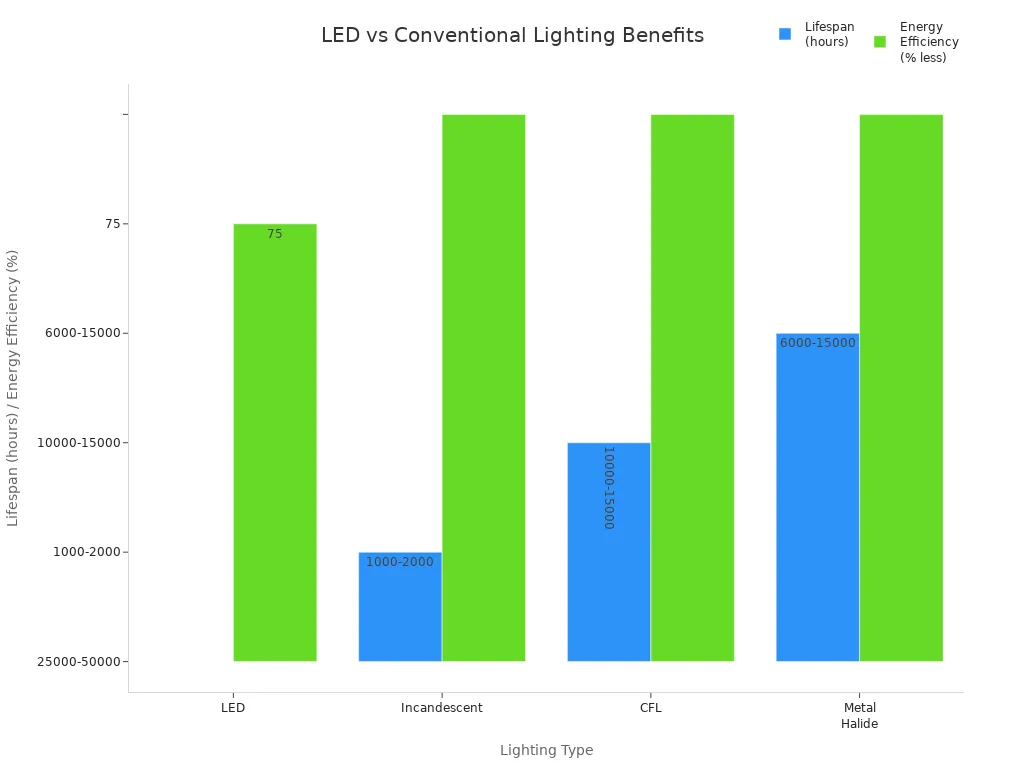
You can see that LED lighting can cut your energy use by up to 80% compared to old lights. LEDs can last up to 50,000 hours or more, while old bulbs may only last 1,000 to 15,000 hours. This means you change bulbs less often and spend less money over time.
Tunable white LEDs also help you make flexible spaces. You can change the lighting for reading, relaxing, or working. Tunable LEDs are now part of smart lighting systems. These systems let you control your lights with apps or sensors. You can set times, change colors, and save even more energy.
Backlit light technology keeps getting better. New trends include lighting that changes color and brightness during the day. Smart systems use sensors to change lighting based on how much daylight is in the room. Many companies now use eco-friendly materials in their lighting products. These trends make lighting more comfortable, efficient, and better for the planet.
You can use backlit light technology in many ways. You can light up signs, make glowing walls, or add accent lighting to art. Tunable white LEDs let you control how your space looks and feels. LED lighting helps you save energy and create the best space for any activity.
Color Temperature in Lighting
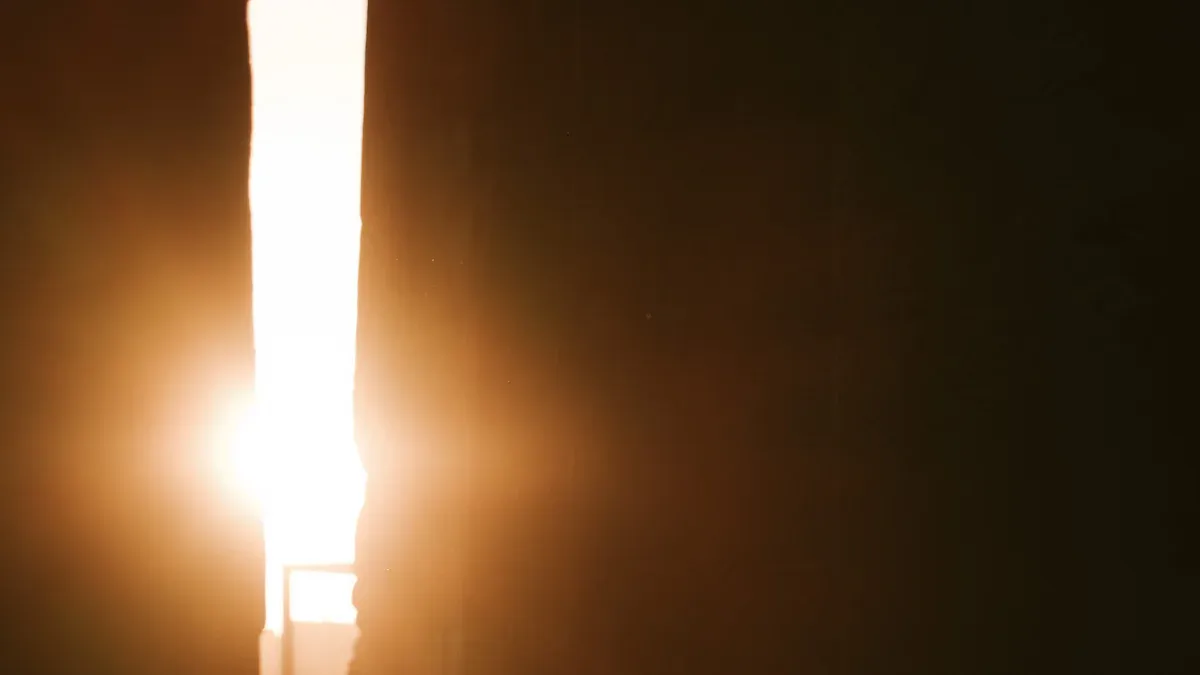
Understanding Color Temperature
When you turn on a light, you see color temperature. Color temperature shows if the light looks warm or cool. You measure color temperature using kelvin. The kelvin scale starts with warm colors and goes up to cool ones. You use color temperature to pick the best lighting for your room.
Color temperature changes how you feel and see things. Warm white light makes a room feel cozy and nice. Cool white light helps you stay awake and alert. Warm white light is common in homes and restaurants. Offices and hospitals use cool white light to help people focus. Color in lighting matters all day long.
Here is a table that shows the usual color temperature ranges:
Color Temperature Range | Description |
|---|---|
1700K | Very, very warm |
2700-3100K | Warm white |
3900-4200K | Neutral white |
5000-6500K | Cool white |
9500K | Very, very cool |
You measure color temperature in kelvins. Warm white light is between 2700 and 3100 kelvins. Neutral white is around 3900 to 4200 kelvins. Cool white is from 5000 to 6500 kelvins. These numbers help you choose the right light for your needs.
Tip: Pick warm white light if you want to relax. Choose cool white light for work or study.
Effects on Mood and Application
Color temperature can change your mood and how you use a space. Warm white light helps you feel calm and relaxed. Cool white light keeps you awake and ready to work. Color in lighting is important because it affects your feelings.
Studies show color temperature can change your sleep and wake cycles. Your circadian rhythm controls when you sleep and wake up. Blue-enriched cool white light, about 5000 kelvins, helps you stay alert and think better. Warm white light, near 2700 kelvins, makes you feel happy and peaceful.
Here are some results from science studies:
Study | Findings |
|---|---|
Grant et al. (2021) | Blue-enriched white light (5000 K) helps you think better than 3000 K. |
Lehrl et al. (2007) | More blue light makes you less sleepy and helps you do better. |
Keis et al. (2014) | Higher color temperature (5500 K) helps you focus and think faster. |
Kuijsters et al. (2015) | 2700 K makes a space more relaxing than 4000 K. |
Wu & Wang (2015) | Warm lighting (2700 K) makes you feel happy and calm compared to cool lighting (5600 K). |
You see why color in lighting matters when you set up your home or office. Use warm white light if you want to relax. Use cool white light if you need to work or study. Color temperature can change your mood and your sleep cycle.
Note: Your body reacts to color temperature. Use cool white light in the morning to wake up. Use warm white light at night to help you relax.
Choosing the Right Color
You need to pick the right color temperature for each room. Color in lighting is important because it matches the light to what you do. You use correlated color temperature to help you choose. You also look at the Color Rendering Index (CRI). CRI tells you how well a light shows colors. High CRI means colors look bright and real. Low CRI makes colors look dull.
Color in lighting is very important in places like art galleries and hospitals. You want high CRI for true colors. At home, you want warm white light for comfort. In offices, you want cool white light for focus.
Here is a table with good color temperature ranges for different spaces:
Application | |
|---|---|
Commercial Office | Neutral to cool |
Lobby Office | 5000K |
Office Corridor | 3000K to 4000K |
Lounge | 3300K to 5300K |
Main Office Hall | 4000K |
You use correlated color temperature to set the mood. For a bright lobby, pick 5000 kelvins. For an office corridor, use 3000 to 4000 kelvins. For a comfy lounge, pick 3300 to 5300 kelvins. For a busy main office hall, use 4000 kelvins.
Offices use neutral to cool color temperature to help people focus.
Lobbies use 5000 kelvins to feel welcoming.
Corridors use 3000 to 4000 kelvins for a professional look.
Lounges use 3300 to 5300 kelvins for comfort.
Main office halls use 4000 kelvins for getting work done.
Your circadian rhythm changes with color temperature. Use warm white light in bedrooms and living rooms. Use cool white light in kitchens and work areas. Color in lighting helps you make the best space for every activity.
Callout: Always check the CRI rating when you buy new lights. High CRI gives you better color and is easier on your eyes.
Brightness and Lighting
Lumens and Measurement
When you choose lighting for your space, you need to know how to measure brightness. The main unit for measuring light brightness is the lumen. Lumens tell you how much visible light a source gives off. If you want a brighter room, you need a bulb with more lumens. Many people used to look at watts, but watts only show how much energy a bulb uses, not how bright it is. Modern lighting, like LEDs and CFLs, can give you more lumens with fewer watts.
Here is a table that shows the typical lumen range for common lighting products:
Light Source | Watts Range | Lumens Range |
|---|---|---|
Standard Incandescent | 40W - 100W | 450 - 1600 |
Halogen Incandescent | 35W - 150W | 550 - 2900 |
CFL | 5W - 32W | 250 - 2600 |
LED Light Bulbs | 4W - 15W | 450 - 1600 |
Floodlight Bulbs | 50W - 500W | 600 - 10000 |
You can see that LED bulbs use less energy but still give you high lumen output. For example, a 100-watt incandescent bulb gives about 1600 lumens, while an LED bulb can give the same light output using much less power. Floodlights can reach up to 10,000 lumens for large spaces.
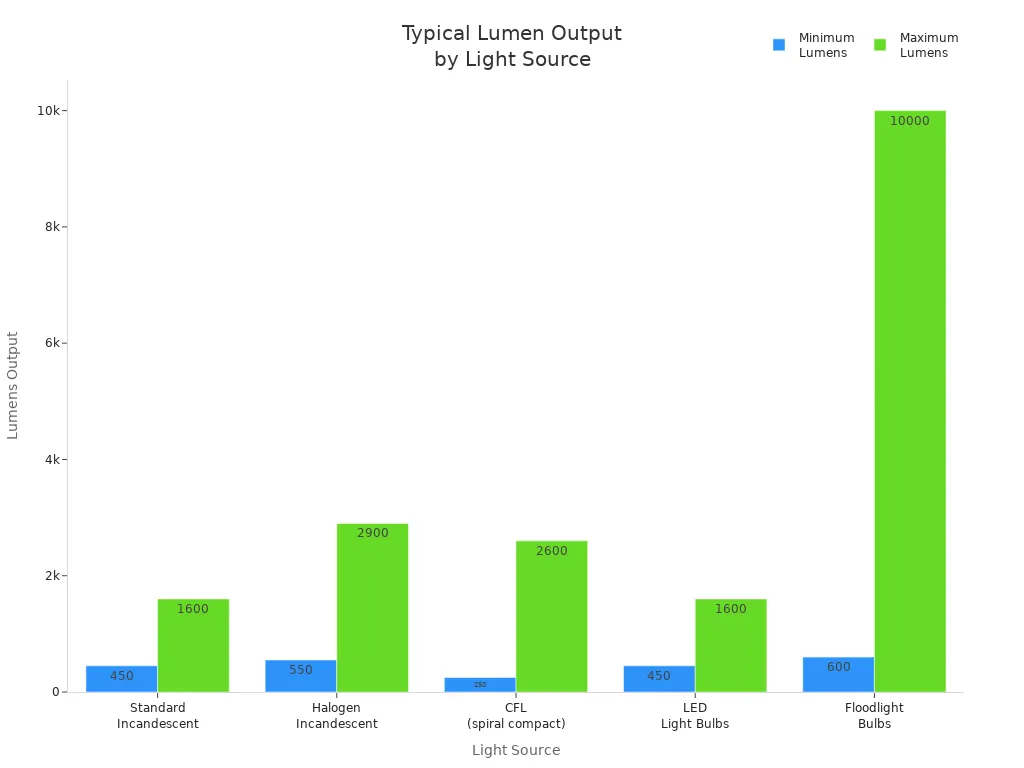
Tip: Always check the lumen rating on the package when you buy new lighting. This helps you pick the right brightness for your needs.
Practical Impacts
The right level of brightness can change how you feel and work in a space. In classrooms, hospitals, and offices, good lighting helps you see clearly and stay focused. If the lighting is too dim, you may feel tired or make mistakes. If it is too bright, your eyes can feel strained. You need to match the lumen level to the activity and room type.
Here are some recommended brightness levels for different spaces:
Activity | Recommended Brightness (lx) |
|---|---|
Public areas with dark surroundings | 20 - 50 |
Classrooms | 300 |
Normal office work, kitchens | 500 |
Supermarkets, workshops | 750 |
Very detailed work | 1500 - 2000 |
Lighting in hospitals and offices affects comfort and job performance. Studies show that better lighting with the right lumen level can improve productivity and reduce stress. In homes, you want lower brightness for bedrooms and higher brightness for kitchens or work areas. Always choose lighting that fits the task and space. This way, you get the best visual comfort and efficiency.
Energy Efficiency
Wattage and Consumption
You make a big impact on energy efficiency when you choose your lighting. Wattage tells you how much power a bulb uses. If you want to save energy, you need to look at both wattage and lumens. LEDs give you the same brightness as incandescent bulbs but use much less power. For example, a 60-watt incandescent bulb produces 800 lumens. You get the same light from a 16-watt LED bulb. This means you use less energy and lower your energy consumption.
Here is a table that shows how different bulbs compare:
Light Type | Watts Used | Lumens Produced | Efficiency (lumens/watt) |
|---|---|---|---|
Incandescent | 60W | 800 lm | 13 lm/W |
CFL | 15W | 800 lm | 53.3 lm/W |
LED | 16W | 800 lm | 50 lm/W |
LEDs use about 20-25% of the energy that incandescent bulbs need for the same amount of light. CFLs also use less energy, but LEDs offer better efficiency and last longer.
Tip: If you switch to LED lighting, you could save about $225 a year on your energy bills. Replacing just one 60-watt bulb with a 10-watt LED could save you almost $10 each year.
Saving Energy with LEDs
LED lighting helps you reach high energy efficiency in your home or business. These bulbs use at least 75% less energy than incandescent bulbs. The Department of Energy says switching to LEDs could save up to 569 terawatt-hours by 2035. This is equal to the output of 92 large power plants. You also help the environment because LEDs last much longer. Most LED bulbs last between 10,000 and 50,000 hours. Incandescent bulbs only last about 1,000 hours.
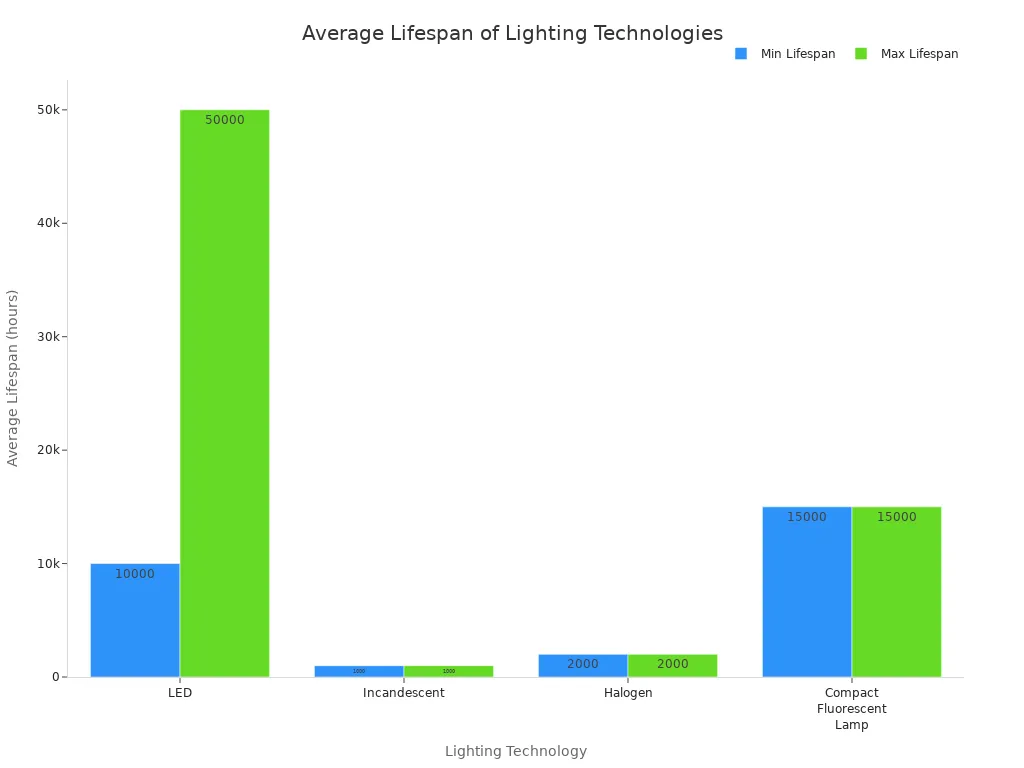
Smart lighting systems make your energy consumption even lower. These systems use sensors and dimming controls to adjust brightness based on how much light you need. Some studies show that advanced dimming can cut energy use by more than 30%. IoT sensors can turn off lights when no one is in the room. You get better efficiency and save more money.
Governments also support energy efficiency. The U.S. and other countries have rules that push people to use efficient lighting. These rules help you save energy and protect the planet. When you choose LED lighting and smart controls, you improve your energy efficiency and lower your energy consumption.
Factors Working Together
Balancing Color, Brightness, and Efficiency
You get the best indoor spaces when you balance color temperature, brightness, and energy efficiency. Each part affects how you feel and what you do. Work areas need more lumens than hallways. For reading or cooking, use 50 to 70 lumens per square foot. Hallways only need about 20 lumens per square foot.
Color temperature changes how you feel and work. Use 3000K to 3500K for neutral light in stores or living rooms. If you want a room to feel lively, pick bulbs with 4000K to 5000K. For a natural look, bulbs between 4000K and 4500K are good. High CRI bulbs, rated 95 or higher, make colors look bright and real. This matters in stores and art displays.
LED bulbs save energy and last longer. You can use smart systems to change brightness and color. Adjustable lighting helps you set the mood for any activity. Offices need the right brightness to help people focus and be creative. At home, dimmable lights help you relax or have fun.
Note: If you do not match color temperature to the room’s use, the space can feel wrong and people may not work well.
Tips for Choosing Lighting
Try these tips to pick the best lighting for each room:
Pick the right lumens for each space. Hallways need 20 lumens per square foot, tables need 30, and workspaces need 50 to 70.
Choose color temperature for the room’s job. Bedrooms and lounges feel warm with 2700K to 3000K. Kitchens and offices work better with 4000K to 5000K.
Use fixtures with a CRI of 95 or more for true color, especially in stores or art rooms.
Pick LED bulbs to save money and get longer life.
Use dimmable lights so you can change brightness for different things.
Let in sunlight by using windows and shiny surfaces.
Mix task, accent, and ambient lights for more choices.
Here is a quick table for common indoor rooms:
Space | Lumen Output (per sq ft) | Color Temperature (K) | CRI | Fixture Type |
|---|---|---|---|---|
Kitchen | 50-70 | 3000-4000 | 95+ | Under-cabinet, LED |
Bedroom | 20-30 | 2700-3000 | 90+ | Table lamp, dimmable |
Workspace | 50-70 | 4000-5000 | 95+ | Desk lamp, LED |
Hallway | 20 | 3000 | 80+ | Wall sconce, LED |
Tip: Always match your lighting to what you want to do and how you want to feel. Do not use the wrong color temperature or forget about dimmable lights.
You have learned how backlit light technology, color temperature, brightness, and energy efficiency all work together in your space. When you want to improve your lighting, think about these important things:
Key Feature | Description |
|---|---|
Energy Efficiency | LEDs use less power than old lights. |
Longevity | LEDs can last as long as 100,000 hours. |
Environmental Safety | LEDs do not have harmful mercury inside. |
Picture Quality | New LEDs show colors and details better. |
Future Technology | Mini-LED and Micro-LED give even more good things. |
Think about what you need and how your space is used.
Pick products that help you feel comfortable and save money.
Look at places like Integrated Lighting Resources or the Chicago Smart Lighting Project for more tips.
Good lighting helps make your home or office brighter, safer, and saves energy.
FAQ
What is the best color temperature for a bedroom?
You should use warm white light, around 2700K to 3000K. This range helps you relax and feel comfortable. Warm light creates a cozy atmosphere and supports restful sleep.
How do you measure brightness in a room?
You measure brightness using lumens. Lumens show how much visible light a bulb gives off. Higher lumens mean a brighter room. Always check the package for the lumen rating before you buy.
Why do LED bulbs last longer than regular bulbs?
LED bulbs use advanced technology that does not rely on filaments. You get less heat and less wear. This design helps LED bulbs last many years, saving you money and time.
Can smart lighting help you save energy?
Smart lighting systems use sensors and timers. You can control brightness and turn off lights when you leave a room. These features help you lower energy use and reduce your electricity bills.
See Also
Energy-Saving Acrylic Box Lights For Contemporary Environments
Key Specifications And Performance Aspects Of Acrylic Light Panels
Innovative LED Technology For Digital Display Solutions
Evaluating LED, RGB, And Battery Options For Acrylic Displays

